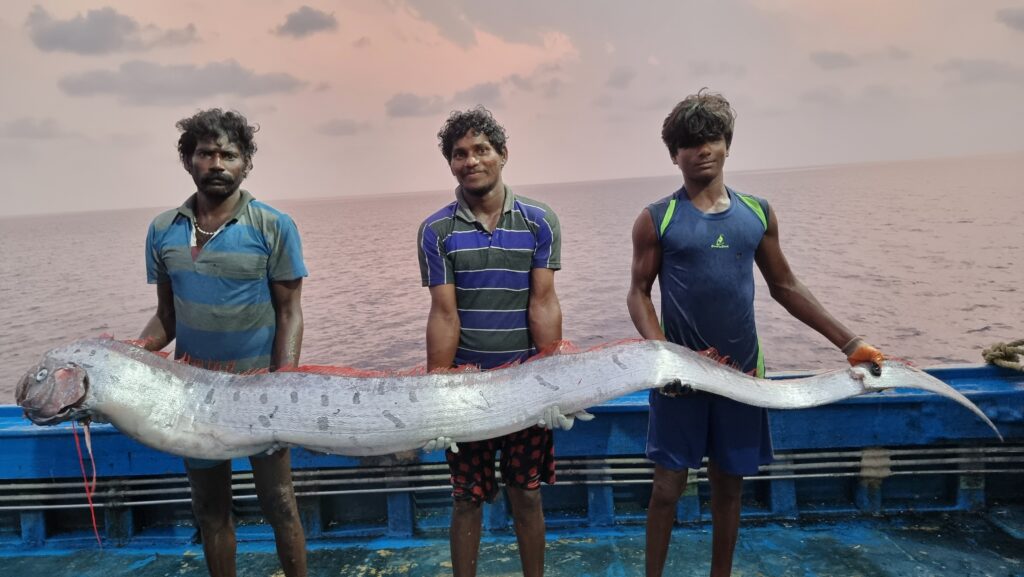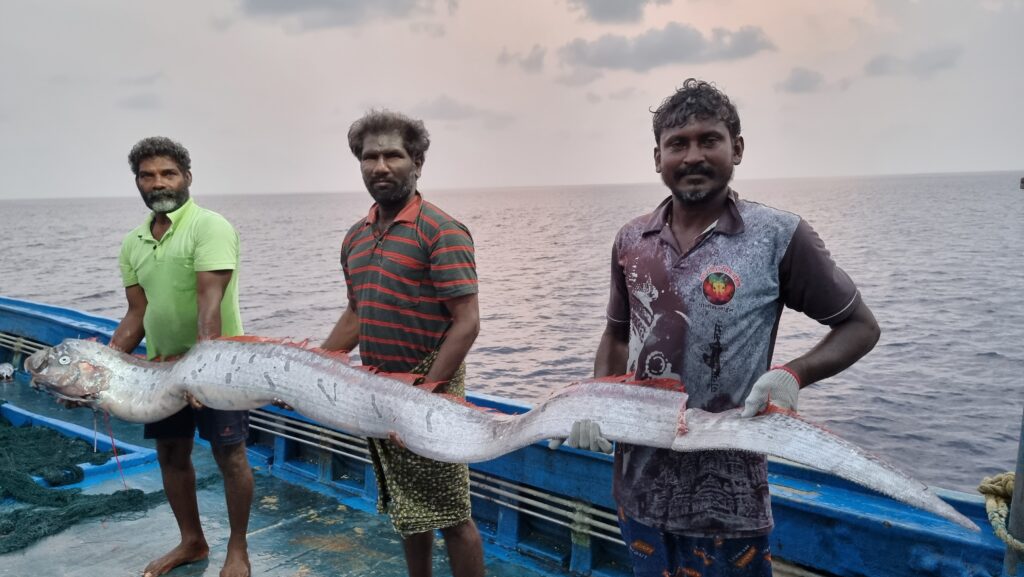
In the unexplored vast waters of the ocean where the sun barely penetrates the ocean are creatures with incredible shapes and behaviours. Of all the deep sea inhabitants there are few that capture the imagination as well as those of oar fish.
Its enormous size its ribbon like body and striking look The oar fish has been the source of ancient myths about sea serpents. It is still awe inspiring to both scientists and people in general. It is often referred to as the “king of herrings” or the “doomsday fish” the oar fish is one of the most mysterious creatures living in the planets most expansive ecosystem deep ocean.
A oar fish belongs to the family of Regalecidae which is derived from Latin the word regalis which means “royal.” There are two very well known species: The Giant Oarfish ( Regalecus glesne) and the slimmer Streamer Fish ( Regalecus russelii).
This Giant Oarfish holds the Guinness World Record for the most bone fish alive. It has been reported lengths that exceed 11 metres (36 feet) and reports from anecdotal sources of even greater specimens. Their size alone combined with its inscrutable nature means that every glimpse of an oar fish a very rare event that is scientifically significant.
Table of Contents
Physical Characteristics and Adaptations of the Oar Fish
The distinct appearance of the oar fish is its distinctive appearance that makes it stand out. The body of the fish is stretched and laterally compressed creating a ribbon like “oar like” shape which many believe is the reason for its common term.
Skin is not scaled being covered by metallic guanine. It may appear to be iridescent when seen in the dim lighting of its marine environment. After death the shiny silver sheen fades quickly leaving beached specimens with appear duller.
One of the most striking features that is unique to The most amazing feature of oar fish is the dorsal fin that runs across the length of its body starting just below its tiny eyes all the way to its tail which taper.
It is usually a vivid pink or red and the initial 10 12 rays becoming the crest of a crown that is adorned by reddish spots and the skin flaps. These pelvic fins are extended and oar like. However contrary to popular belief that theyre not utilized to propel the fish.
but they are believed to be involved in the sense of taste. They are also thought to be involved in taste perception. oar fish lacks an anterior fin. Its caudal (tail) fins are either extremely small or missing as the body droops into a point.
In contrast to other fish like unlike most fish oar fish does have a swimming bladder. Instead it preserves its buoyancy through the skeleton of low density gelatinous as well as muscle.
This lets it float horizontally within the water column and in most cases by inclining its head toward the sky an arrangement thought to aid in camouflage as well as in the ability to spot prey coming from below.
The vertical position also permits it to let go of the long dorsal fin in order for a propelling motion through the water in a distinctive “amiiform” mode of swimming. This unique style of swimming enhances the mystery that surrounds this oar fish.
Habitat and Distribution: Where Does the Oar Fish Reside?
It is believed that the oar fish is an oceanic species living in the mesopelagic (twilight) as well as bathypelagic (midnight) areas of the ocean. They are typically in depths of 200 to 1000 metres (650 up to 3300 feet).
These areas are marked by extreme pressure complete darkness and freezing temperatures. The silvery and reflective bodies of oar fish helps to blend in with the surrounding environment by reflecting dim light. This helps in camouflaging against predators.
Despite the fact that it is a deep dwelling fish however this oar fish has an extremely wide range of habitat. It can be present in temperate and tropical oceans across the major ones that include those of the Atlantic Pacific and Indian Oceans.
It is not found in the regions of Polarization. The cosmopolitan nature of its distribution indicates a strong adaptation to a variety of deep sea conditions. Yet the sight of a live healthy oar fish in the natural setting is unusual.
The very first footage that was confirmed of an actual oar fish at its native vertical position was recorded by the U.S. Navy in 2001 and demonstrates how inaccessible the creature can be.

Diet and Feeding Habits: What Does the Oar Fish Eat?
Despite its massive dimensions regardless of its massive size oar fish is an oar fish that is a filter feeder. The mouth which is small and protruding has no teeth visible and it is equipped with specifically developed gill rakers.
The feathery structures function as an oarfishs sieve and allow to allow the oar fish to remove huge amounts of small marine life from the aquifer. The majority of its diet is the krill (euphausiid shrimps) and other smaller crustaceans as well as tiny squids or larval fish.
The orientation vertical of the oar fish is considered to be a factor in its strategy for feeding that allows it to search the waters above to find the presence of plankton. While eating it swallows the water through its gills employing its gill rakers in order to eliminate its small prey.
The unique feeding method can be a testimony to the diversity of adaptations within deep sea organisms and demonstrates that even predators with the biggest size can survive on most tiny of creatures.
What is the reason oarfish are called “doomsday fish”
“Doomsday” means that the end of the world. Oarfish also known as doomsday fish is the result of popular mythology that says the sighting of an oarfish can predict natural catastrophes. Oarfish frequently appear in legends of disaster specifically in people of the Japanese as well as Philippine people.
An oarfish that swims on the beach is thought to indicate an impending natural catastrophe according to Japanese myth.Sightings in the ocean of strange ocean phenomena continue to be a source of mythological belief and legends particularly in seismic hazard regions.
- Earthquakes Oarfish from countries like Japan as well as the Philippines are thought as harbingers for the approaching tsunamis and earthquakes. This theory became popular in the aftermath of the earthquake of 2011 Japan earthquake. In the days prior to the earthquake a few Oarfish were spotted washing up in the oceans.
- Unique surface observations:Because oarfish are deep sea species their surface appearances appear unusual and are believed to be signs of disorientation or disease which is a further reason to believe in the myth.
- Legends of the sea monster from ancient times: Because oarfish have unique shapes and an impressive dimensions they are the subject of mythological stories about sea monsters. Their distinctive wavy movement is just one of what contributes to their mystery.
Although most believe that the sight of an Oarfish is a sign of disaster theres science has not proved this even with many theories.
Oarfish: Increasing threat from human activities
Although they are of great interest to scientists however the oarfish as with all marine creatures in deep seas are facing increasing threat from human activity.
- Plastic pollution Deep sea ecosystems as well as the animals living in them are devastated by marine pollution especially plastics.
- Climate changeRising temperatures of the ocean could pose danger for the fragile equilibrium of the deep sea ecosystem and could cause a redistribution of marine species.
- Deep sea fishing and exploration:Deep ocean human presence which includes fishing and exploration has been increasing and may be a threat to oarfish as well as other marine animals in the deep ocean.

Oarfish sightings in the past
Oarfish have been connected to earthquake activity for quite a long duration and these mysterious creatures often appearing prior to large earthquakes.
Here are some of the previous disasters which were caused due to appearance of oarfish according to the myth. Though some think that their appearance predicts catastrophes but this isnt often the case.
- 2011. Japan 2011 Japan Tohoku Tsunami and earthquake came shortly after the appearance of oarfish in the waters of Japanese shores.
- 2017 Philippines Philippine: The Philippines in 2017: 6.6 earthquake was reported due to an oarfish sighting the Philippines.
- 2013. California USA: A carcass of an oarfish was discovered along the shore however it was not a tragedy and reaffirms that it is not always the sightings of earthquakes followed by a tsunami.
There are very few occasions to meet an actual oar fish at the surface along with its stunning and slender appearance has led to its presence in mythology and folklore. Perhaps most famously it is believed that the oar fish is often referred to as “Ryugu no tsukai” in Japanese mythology.
It is the “Messenger from the Sea Gods Palace.” In the ancient mythology that the sight of An oar fish near the waters surface or washed up on shore can be a sign of imminent natural disasters like tsunamis and earthquakes. This mythology has an extensive history that dates from the seventeenth century.
The myth gained a lot of traction throughout the world in 2011 after a few oar fish had been located washed up ashore in Japan during the weeks preceding the catastrophic Tohoku Earthquake and Tsunami. Although these coincidences led to many speculations the scientific consensus states that there isnt a evidence based connection to oar fish sightings or earthquake activity.
Researchers suggest that if you see an oar fish is found in shallow water usually its because it has a plight is disoriented or taken in by strong circulations that may have been dragged towards the surface due to extreme storms or other unusual underwater phenomena.
In spite of the fact that scientists are skeptical however it is believed that the “doomsday fish” moniker and its associated myths continue draw attention and interest highlighting the human need to discover patterns and signs within natural phenomenon.
The Elusive Behavior and Reproduction of the Oar Fish
Because of its deep sea habitat there isnt much known regarding the behaviour and reproduction cycle of oar fish. Scientists have seen only just a few live specimens within their natural surroundings making the study of detailed details difficult. The oar fish is predominantly solitary. However studies of numerous individuals close proximity to each other have been reported.
Concerning reproduction its well known it is believed that oar fish is uniparous. This means that it lay eggs which develop and hatch without within the body of females. One female could produce hundreds of thousands or millions of eggs.
The eggs release into the water column. They then flounder free. The larvae are planktonic and moving with the flow until they are sufficient to reach the depths of the sea. The life span for an oar fish is thought to be between 20 and 30 years. However this estimation is based on a small amount of data.
Conservation Status and Threats to the Oar Fish
The International Union for Conservation of Nature (IUCN) is currently defining it as the Giant Oarfish ( Regalecus glesne) as an animal of “Least Concern.” This is due in part to its extensive distribution and also its fact that it has little commercial value since the meat of this fish is gelatinous and is not edible. This is why this oar fish is not a target for commercial fisheries.
As with other marine life particularly deep sea fish however the oar fish is in no way immune from the human effects. Sometimes they are caught as bycatch from deep sea trawling nets however such incidents are extremely rare.
Plastic pollution is on the rise and microplastics in the water column has become a growing issue for organisms that filter feed such as Oar fish. oar fish since these contaminants can be a part of the food chain.
In addition climate change as well as modifications in ocean currents or temperatures can alter their habitat in deep seas as well as food sources but the effects over time are unexplored. Scientists insist that continuing investigation into the depths of the ocean is essential to comprehend the population health and trends of mysterious species such as those of oar fish.
The Allure of the Deep: Why the Oar Fish Continues to Captivate
It is believed that the oar fish represents all things mysterious and fascinating about the vast ocean. The sheer size of the fish its alien appearance and a few appearances close to the surface are a part of its illustrious reputation.
Its a stark reminder of just how little we are aware of the vast most of the planets inhabitants space. Every sighting of or oar fish whether it is alive or lying on the beach is a wonderful occasion for scientists to accumulate information and discover the mysteries of this amazing species.
With the advancement of technology which allows to conduct deeper and more extended submersible explorations we could get a better insight of the behavior as well as the ecological functions of oar fish.
To this point the magnificent large scale ribbon fish will rule as one of the oceans most mysterious and fascinating inhabitants always telling tales of undiscovered deeps and reminding us of the amazing things that lie in the depths of the ocean. A mere sight of an impressive oar fish stirs a deep feeling of fascination and reverence to the world of nature.
=====================================================================
